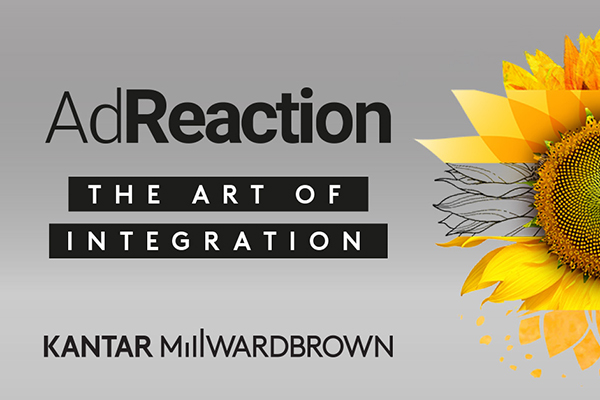AdReaction 2018: More than half of marketers not integrating their multichannel campaigns effectively

- 80% of consumers in New Zealand see ads in more places compared to 3 years ago
- 94% of marketers in APAC think that they deliver well-integrated campaigns
- But only half (54%) of consumers in New Zealand think that ads fit together cohesively
The variety of channels available to marketers has increased exponentially, however ineffective multichannel strategies are jeopardising the success of campaigns. This is according to AdReaction: The Art of Integration, a new study from Kantar that examines the global state of multichannel advertising campaigns, drawing on quantitative research in 45 countries, multichannel copy testing, and custom analysis of Kantar’s global media effectiveness and copy testing databases.
In New Zealand, 80% of consumers surveyed report that they are seeing more ads in a wider variety of places than they did three years ago.
An increase in channels provides an array of new approaches for brands. Marketers are confident in their ability to deliver campaigns across these multiplying channels, with 94% in APAC believing they deliver integrated campaigns.
Yet consumers are less positive about how well marketers are integrating their multichannel strategies. Only half (54%) of consumers in New Zealand agree that ads they see across channels such as TV, outdoor and digital ‘fit together well’.
In fact, Kantar’s analysis of global campaigns within its media effectiveness database revealed that in contrast to the confident view of marketers, fewer than half (46%) of all campaigns tested in the study could be marked as well-integrated, suggesting that consumers’ views are closer to reality than marketers’.
Integration across channels offers marketers the opportunity to boost campaign effectiveness, as the results from the study show that well-integrated and customised ad campaigns can improve overall campaign effectiveness by as much as 57%. This means that brands can get more impact from their investment. More than half of marketers are therefore missing out on the opportunity to substantially boost their activity.
What’s more, ineffective and disjointed advertising runs the risk of alienating consumers. Many surveyed in New Zealand said they were uncomfortable with this increase in advertising, with 76% agreeing that ads are more intrusive now. The fact that three quarters of Kiwis see advertising in a negative light should be a wakeup call for marketers in the country.
Duncan Southgate, Kantar’s Global Brand Director, Media & Digital, says: “Consumers feel overwhelmed by advertising from all angles while marketers struggle to make the most of ad formats and channels to best reach consumers, and the latest AdReaction report unveils a disconnect between how marketers and consumers perceive campaign success. In AdReaction, we’ve laid out guiding principles to help marketers better integrate campaigns across channels and identified the key creative elements of successful campaigns as best practices.”
AdReaction: The Art of Integration identifies several guiding principles for brands to consider when implementing multichannel campaigns that build successful brands and avoid the pitfalls of fragmentation.
1. Integrate more campaign cues: Even without any customisation, integrated campaigns are 31% more effective at building brands, yet still one in four of the campaigns analysed were not well integrated. The more cues used, the better. Consumers expect multichannel campaigns to deliver basic connective elements like the same logo and slogan. However, the study shows that consistent characters or personalities are the individual cues which most help brand impact, often differentiating the best campaigns. The report also found that all channels benefit from synergies, but some channels work particularly well with each other. The strongest overall synergy combinations are between TV and Facebook, and TV and outdoor.
2. Start with a strong campaign idea: The idea is the most important component of the campaign. Great campaigns need a strong central idea to act as connective tissue across all content, and integrated content needs to cue this idea. Campaigns with a strong central idea perform better across all brand KPIs (+64%), especially brand image associations (+91%), as well as across all channels.
3. Make each ad in an integrated campaign amazing: Within the multichannel pretesting, we see a campaign is defined most closely by the average of all executions, even more so than the best or worst individual execution. Unless media spend will be skewed towards one execution, every piece of content matters and contributes to overall success and brand building.
4. Invest only in channels that have a clear role in the campaign: Marketers need to choose channels wisely – only using those which have a clear role in the campaign and in reaching the target audience. It’s also important to understand what each channel can deliver in terms of impact and cost. For example, online ads are cost effective in extending TV reach and building brand metrics from awareness through to purchase intent. However, consumers’ attitudes are more positive to traditional media than online advertising and people are more likely to recall negative online targeting experiences than positive ones.
5. Customise content for each channel: There is a sweet spot between integration and customisation. A strong integrated campaign must be flexible enough to enable novel, complementary content, but familiar enough to link the key campaign elements tightly together.
For more information please contact Kerri Tait.

KERRI TAIT
Chief Client Officer
[email protected]
Insight and thinking
Read our latest articles and reports, with expert perspective, proprietary data, and thought-provoking insights.